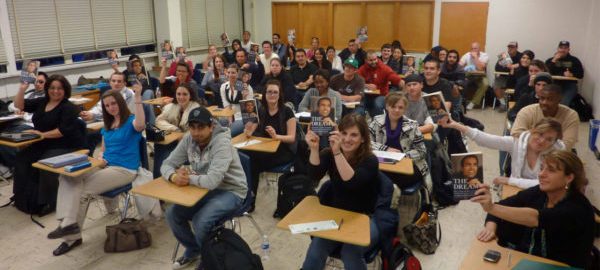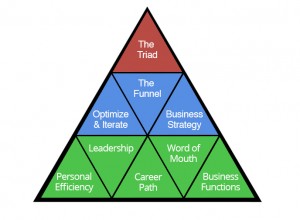
Although I dropped out of high school at the age of 16, to pursue my dreams in business, I have never downplayed the importance of education. Quiet to the contrary, I have often stated in all of my guest lectures for students to stay in school, and to never stop learning – for it is a lifelong journey. Even through my foundation, I do my best in give students the opportunity to gain institutional knowledge via means of scholarships, mentorships, and refurbishing dire schools.
But, if I had not dropped out and were graduating today, what would I be doing?
First and foremost, I have always felt that if you do what you love, you will spend the rest of your life loving it – that it will never feel like work. Second, I’ve always desired to make a positive difference in the world. With these two principles as my guideline, and my passion to stay focused in the emerging technologies, I would have picked a profession where I would continue to learn – daily – and raise the bar higher for everyone else around me.
I have always said each day is a new opportunity. For me, I graduated from my last company and now at Gravity4 I am on to learning machine learning, deep learning and ways in which Artificial Intelligence would enhance our lives. It is vastly different than how I started out when I was 16. My learning never ended. Because, when the learning ends, someone else behind you is ready to pickup where you left and move on ahead of you. So, my advice to the graduating students is: Always continue to learn. School ends but learning never does.
Although unemployment has been at 4.5% for a long period, many jobs remain unfilled in the US and other countries. The majority of these jobs have one common thing- they lack suitable candidate with sufficient skill sets. I must emphasize for clarity that it is not that the US lacks headcount of people willing to work, rather, there is skills shortage.
In one of the high schools I recently mentored, I was asked by the graduating senior to explain more about their “STEM program”. Most people in the valley are aware of the term. However, I realized that sometimes in the technology sector are so enveloped in our bubble that we often forget the world around us doesn’t speak the acronym language. As we head towards Artificial Intelligent based technology era – fact-based, rules-based, and left-brain skills are critical. It is important for us to ensure we arm the youth with all the skills they will need to make a meaningful impact.
So, in this this piece I am aiming to share quick overview of STEM & ways in which individuals should prepare themselves. In nutshell, STEM is a reference to a curriculum based on the notion of educating students in four major disciplines: Science, Technology, Engineering, and Mathematics. Currently, the most unfilled jobs in technology and research based facilities require skills from these areas. Graduates with backgrounds in science, technology, engineering, and math (STEM) can generally find suitable entry level positions as these skills are in high demand and will be for the foreseeable future.
Even Bill Gates, the world’s richest person in the world says these 3 fields have the most potential to change the world.
“One is artificial intelligence. We have only begun to tap into all the ways it will make people’s lives more productive and creative. The second is energy, because making it clean, affordable, and reliable will be essential for fighting poverty and climate change. The third is the biosciences, which are ripe with opportunities to help people live longer, healthier lives.”
STEM education takes an applied and interdisciplinary approach. Instead of teaching these disciplines as discrete and separate subjects, it integrates them to form a cohesive paradigm for learning that is based on the real-world applications.
Countries like the United States have historically led in the technology fields. However, fewer students have been focusing on these subjects. The U.S Department of Education, for instance, reports only 16% of students in high school have proven their mathematics proficiency and are interested in STEM careers. Although almost 28% of high school freshmen express their interest in STEM related fields, 57% of them lose interest before they finish high school education.
But, why is our current school systems falling short in providing sufficient STEM prepared youth for the job sectors? It’s a clear that the world need professionals with STEM qualifications or backgrounds and this demand is increasing. Then why are only few students are encouraged to pursue studies in the related fields?
Let’s evaluate this with light ‘statistics’ & history
The answer being many schools continue to focus on “memorization” than on problem-solving education. This derails students’ interest away from the STEM subjects – and frankly, is the most boring way to learn. Students are inherently curious – if we spark their interest at an early age, it could instill a lasting desire to pursue a career in any of these fields.
If I were to ask my friends in India (and even in some schools here in the US), the focus on Math/Science is still primarily on memorizing. We need to move away from this method – as fast as humanly possible. Instead, the focus should be on collaboration and teamwork. After All, this is how we work and build great products.
When I look around my company, Gravity4, I see teams working in “collaboration” – not in silos or in competition against each other. Product development, sales strategy, even global financing work as a “TEAM” – with each individual owning a critical piece to the task – best suited for their skillset. The success is ultimately determined by individual contribution cummulating towards a common goal.
STEM lessons focus on real-world issues and problems. These lessons focus on hands-on & collaborative approach, where the path to learning is open ended. STEM also focuses on teaching the students to reframe the failures as a necessary path to learning. Those of us who have been entrepreneurs all of our lives – wish we had this time of trying while growing up. Point being, STEM lessons planning fundamentally requires a different dynamics of lesson plans and retraining for the teachers to prepare for the new curriculum.
However, the policy makers have not accorded STEM education the recognition and funding it requires for this change on larger scale. In many states, there has been no efforts placed towards developing the necessary programs and supporting the training for the STEM educators.

Projected Growth in Jobs in STEM
Where are we headed?
Scientific innovations have become very important in the current trends of knowledge-based economy and globalization. To succeed in a highly technological and information-based world, students need to develop capabilities in science, technology, engineering, and mathematics beyond what was initially considered acceptable.
Clearly, the current gap between the high demand for STEM skills and jobs that require them is widening. Experts have noted that in the next ten years, 80% of most professions will need STEM skills. Meanwhile, our output of graduating students with this skillset is a drop in the ocean. In fact, 57% of students are currently struggling to meet the requirements for basic skills in math. Most students opt not to take advanced or elective courses that are necessary to pursue STEM-related studies. As such, the numbers of jobs that need advanced programming skills continue to increase.
Only the advanced and adequate skills in the trending sectors will establish a competitive global economy.
Global Effort
I am great proponent of education. The foundation I created offers scholarships to young minds to acquire higher education – regardless of their economic difficulties. I believe technology has advanced well enough that we no longer are held behind the geographical barriers. Students should access free online resources, through distant learning, to learn on various subjects and can do so on their own time as well as at their own pace.
If students reside in countries where regulation is slow to bring change, I encourage them to use Distant Learning to give them the competitive advantage. There are multitude of places students can take free courses or low cost course. Some even include certification training on: cyber security, computer science classes, advanced mathematics, deep learning, machine learning and several programming languages.
But, don’t take my words for it, just make sure you love STEM.
After all, the Einstein once said, “You can’t blame gravity for falling in love.”
(37)








